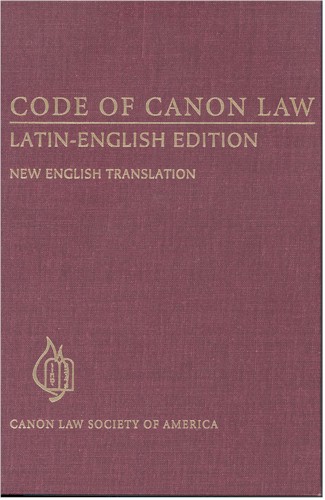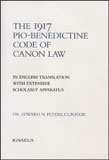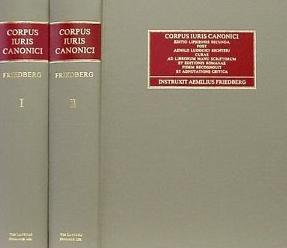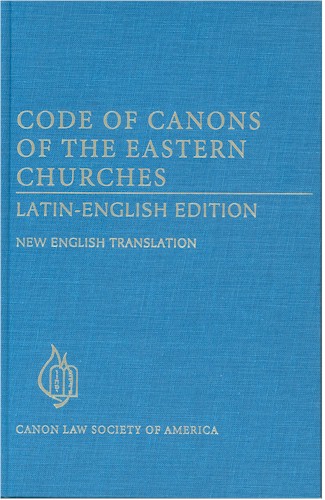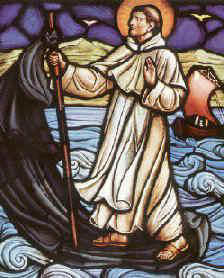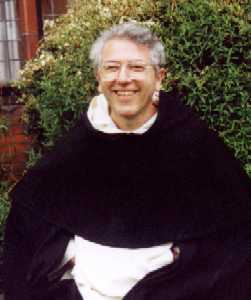|
To work for the proper implementation of canon law is to play an extraordinarily constructive role in continuing the redemptive mission of Christ. Pope John Paul II |
|
|
|
|
Resolution 1152 x 864 |
Updated 17 jan 2013 |
Reviews of Tabulae Congruentiae (2000) |
|
Paul Barber, in Ecclesiastical Law Journal 7/25 (July 2004) 489. |
The Tabulae Congruentiae, complied by Peters, is published in the "Research Tools" section of the Gratianus Series, and is a table listing every part of every canon in the 1983 Code, and giving its complete legislative history. Thus the table gives the equivalent canon in the 1982 Schema, a reference to any discussion at the 1981 Plenary meeting of the Code Commission, the canon in the 1980 Schema, references to the coetus discussions reported in the Communicationes and, finally, the first version of the canon in one of the original ten individual schemata for the Code issued between 1972 and 1977. The book has an informative introduction in five languages (including English). This work has a much more limited appeal than the translation of the 1917 Code--it is not much use unless you actually have access to the various draft versions of the 1983 Code. However, it is likely to prove invaluable forth canon lawyer who wants to interpret the laws of the current Code in accordance with the "mind of the legislator" (Canon 17). It is bound with a black plastic ring binder which, although it does not look particularly attractive on the shelf, is highly practical as the tables are in landscape format.
I recently heard it suggested that Edward Peters was "the Roman Catholic Gerald Bray". In many ways this is true. Both have undertaken a momentous task which most of us would never wish to undertake ourselves, but are continuously grateful that someone else has already done it for us. Just as Professor Bray's collections allow us to trace the development of Anglican canons from their earliest sources through their attempted codification in the Reformatio Legum Ecclesiasticarum to the present day, Dr. Peters' two works allow us to do the same for the Latin Catholic Church from the law's first codification to the enactment of the current Code. These are important works which deserve a place in every canon lawyer's library.
|
|
George Stuart, in The Jurist 60 (2000) 212-214. |
Someone wrote that a true benefactor of humanity does not write a novel, but instead compiles interest tables, assembles weather data, or computes improved actuarial statistics. Researchers honor the memory of the late indefatigable Xavier Ochoa, who complied concordances to the conciliar documents and the 1983 Code, as well as the Leges Ecclesiae. Edward Peters is a benefactor in the same tradition. He has authored many books and articles aimed at general audiences and at specialists: this book is meant for the latter.
The book is comprised of a table of six columns that runs for almost 200 pages. The introduction (provided in five languages) explains the organization and meaning of the table, and in effect gives a concise and detailed account of the mechanics of the revision of the code. The first column lists canons or parts of canons of the 1983 Code; the second shows the numbers of corresponding draft texts in the 1982 schema; the third column gives references to the Relatio Complectens; the fourth shows the numbers of draft texts in the 1980 schema; the fifth, “Disceptatio in coetu,” gives references to Communicationes where discussions of revisions can be found; and the last column ties the canons or sections to sources in the Lex Ecclesiae Fundamentalis or the separate schemata.
In his foreword Craig A. Cox points out that this table can be linked to others that relate the 1983 canons to their 1917 counterparts and with the fontes of both. The 1990 Code of Canons of the Eastern Churches could also be linked in this way, as could other texts. Peters believes in consulting original sources; indeed, he has just published the first true English translation of the 1917 Codex Iuris Canonici, nearly twenty years after that code was abrogated. On an internet site he has stated his belief that “the laws of the Church protect the freedom of the Holy Spirit to act within the faith community,” and that it is his goal “to familiarize students with actual texts of canon law, so that they can come to an appreciation of its liberating and stabilizing effects in the Church, and so that they can better apply the Church’s juridic wisdom in their own lives, ministries, and apostolates.” Cox relates awareness of earlier drafts of the canons to the recourse to “parallel places, the purpose and circumstances of the law, and the mind of the legislator” (c. 17) that is essential to proper interpretation. The table’s value lies in its pointing directly to the texts that trace how the 1983 Code came to be, rather than describing or commenting on them.
While the book is helpful simply as a visual aid in mapping out the revision process and organization of the 1983 Code, it is especially useful because the sources involved often are not user friendly. A researcher uninitiated in their mysteries may not even be sure whether all the pertinent sources are at hand. The fact that Peters acknowledges the help of others in rounding up the references needed to compile his table only underscores its utility. The book also features a bibliography of these original sources.
Peters acknowledges that the correlations in the table are his own, and he admits that his judgments regarding relationships between texts that were extensively reworked over a period of years may be debatable. That the table should not be used uncritically makes it all the more important to refer to original texts; but it is, after all, the book’s purpose to guide users to those texts. Peters’ compilation will save countless others much labor and aggravation in the years to come. For anyone interested in the history of canon law or the code revision process, this book is well worth the modest price.
|
|
Robert Ombres, op, in Canon Law Society of Great Britain and Ireland Newsletter (Sep 2000) 67-68.
|
All laws have a history leading up to their promulgation, and it is often desirable to know the steps by which a canon came to be formulated. A knowledge of the “legislative history” of the canons can be of help in interpreting a canon, and it is often needed to gain a full understanding of the law as it has come to be. All this explains the frequent recourse by canonists working on the 1983 Code of Canon Law to the material in Communicationes, still in the process of being published. The Canon Law: Letter & Spirit, the commentary prepared by the Canon Law Society of Great Britain and Ireland, has a great many references to the stages that led to promulgation.
Dr. Peters has just produced a
most useful set of tables to facilitate the task of reconstructing how the
canons in the 1983 Code came to take their present form. At first glance, a book
with its title in Latin and consisting of six columns of numbers seems
impenetrable and uninviting. Once the nature of the work is explained, its value
is apparent.
The work's nature is well
explained by the author himself in his introduction, which is published in
English, French, Italian, Spanish and German. To trace the development of any
canon in the 1983 Code, first find its number in column 1 and then move to the
right of it along a horizontal line. Each of the five columns to the right of
any given canon number has information of a different kind, where this is
available. There might be citation of the same provision as it appeared in the
1982 Schema; there might then be the page number of the 1981 Relatio covering
the plenary meeting of the Code Commission of that year; then might come a
reference to the 1980 Schema; any Disceptatio in a coetus
discussion might follow; and the final column headed Prima versio canonis contains
material derived from one or more of the ten individual schemata of canons in
their first form.
The method is, of course, easier
to grasp if one can actually see the tables. Dr Peters rightly disclaims any
official authority for his tables, and anyone who has done this kind of
investigation into the formulation of canons (albeit on a much more modest
scale) will know it can be controversial to claim a particular “pedigree”
for certain canons. Sometimes, as with the canons on consecrated life, earlier
versions of the canons were reworked to such an extent that correlation is very
difficult and Dr. Peters is ready to admit this.
Only detailed consultation over a fair period of time will bring out the merits of these tables and any lapses. Some particular points are, however, worth noting straightaway because, as well as being of intrinsic interest; they serve to underline the value of this publication. Occasionally, Plenaria discussions were inadvertently omitted from the relatio but were later published in Communicationes. For an example, see the history of Canon 277 §1 on clerical celibacy.The small exchange within the Commission reported there is also evidence of the delicate but fundamental task of distinguishing canon law from moral theology. Conversely, some of the discussions to be found in the Relatio are absent from the pages of Communicationes. The history of Canon 96, a most significant canon on the consequences of baptism, is an example of this. We can conclude with Canon 1403 on canonisation. It has no predecessor in the Code's legislative history, yet its text was discussed (and rejected) during the Plenaria. Dr. Peters makes reference to what he describes as “this unusual discussion”.
When Dr. Peters tells us that there are some 25,000 pieces of
information in the tables he has compiled, we get a measure both of his
achievement and of the valuable quarry he has made available.
|
|
Canon Law Abstracts (no. 85, 2001) 7. |
This book consists of a series of tables designed to facilitate research into the legislative history of the 1983 Code. To trace the development of any provision of the Code, the tables enable the reader to see the same provision as it appeared in the 1982 Schema, and, where relevant, the page of the 1981 Relatio wherein the provision was discussed at the 1981 Plenaria. If the Plenaria discussion was also printed in Communicationes, that discussion is cited by volume and page number. The citation of the provision is also given as it appeared in the 1980 Schema. A separate column, headed Disceptatio in coetu, gives the citation, by volume and page, of Communicationes, for any coetus discussion(s) of the provision. Finally the citation is given of the first form of the provision as it appeared in one or more of the ten individual schemata of canons.
|
|
Dominique LE TOURNEAU, in Ius Canonicum 41 (2001) 799-800.
|
El objeto de estas Tabulae es facilitar la labor de investigación del canonista que se encuentra frente a las distintas redacciones de los cánones del Código de la Iglesia latina a lo largo del iter de recognitio del Código anterior. El trabajo, que comprende nos menos de 25.000 datos informativos, se presenta en seis columnas. La primera relaciona los cánones uno por uno, con una línea distinta para cada párrafo o subdivisión del canon. En la segunda columna encontramos la numeración correspondiente en el Schema de 1982. La columna siguiente se refiere a la Relatio complectens de 1981. En la cuarta columna, seguimos remontándonos en el tiempo, y tenemos los datos correspondientes al Schema de 1980. A continuación viene la Disceptatio in coetu de los distintos cánones, tal como figura en la Revista Communicationes. El autor señala que en determinados casos no le ha sido posible localizar una discusión del coetus acerca de una norma concreta (lo que materializa con una casilla gris sombreada). Finalmente la última columna da la prima versio canonis, o sea la referencia original de las disposiciones sometidas a los trabajos de los distintos coetus constituidos para ello.
Por último
tiene cuidado el autor de indicar que las correlaciones son suyas, y carecen de
carácter oficial. En la mayoría de los casos no parece que puedan ponerse en
tela de juicio. Pero en determinados casos, no es fácil afirmar con toda
seguridad que una versión posterior de un canon deriva realmente de la versión
anterior, debido a los múltiples e importantes cambios que ella conoció. Por
ello, si se hace referencia a más de una versión anterior como fuente de un
canon del Código de 1983, esto no implica necesariamente que cada una de las
disposiciones anteriores haya contribuido de la misma manera a la versión final
del canon.
Como está
indicado a continuación del título de la obra, en una introducción el autor
explica la forma en que ha de utilizarse su trabajo, con precisiones para la
recta lectura de cada columna. Da también la lista de las obras citadas. La
versión francesa de dicha introducción se debe a Michel Thériault, y su
revisión a Marie José Thériault; la versión italiana respectivamente a Marie
José Thériault, Lamberto Tassinari y Michel Thériault, la española a Iliana
Auverana y Ernest Caparrós, y la alemana a Eva Milde-Hébert y Nikolaus Schöch.
Huelga decir que el trabajo de Edward N. Peters, J.D., J.C.D., del Office for Canonical Affaires de San Diego, en los Estados Unidos, es sumamente útil, y no cabe duda de que en breve tiempo ningún canonista podrá prescindir de las Tabulae.
|
| Other |
=, Anuario Argentino de Derecho Canonico 7 (2000) 231-232.
Heribert Schmitz, Archiv für katholisches Kirchenrecht 168 (1999) 609-610.
|
